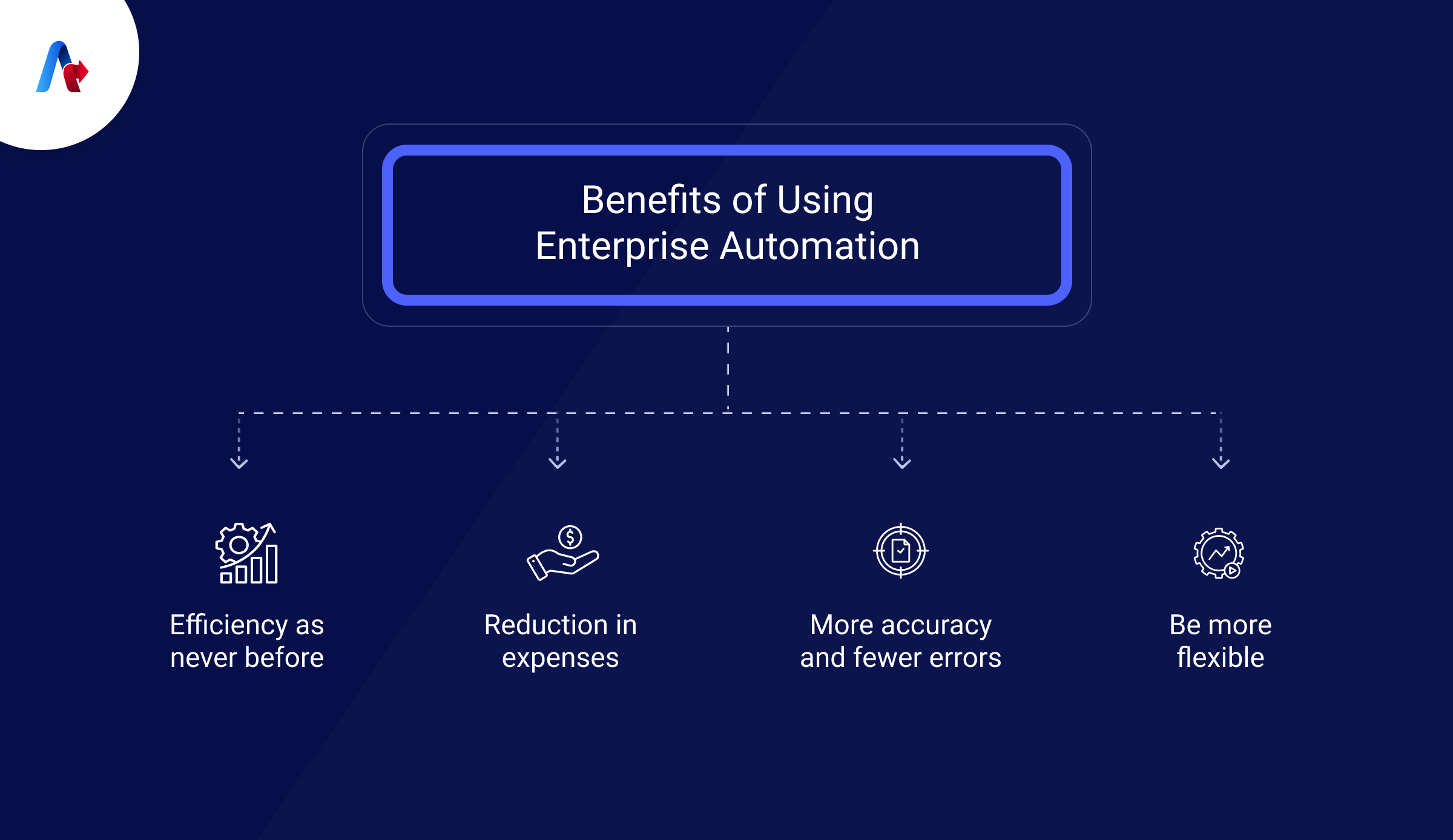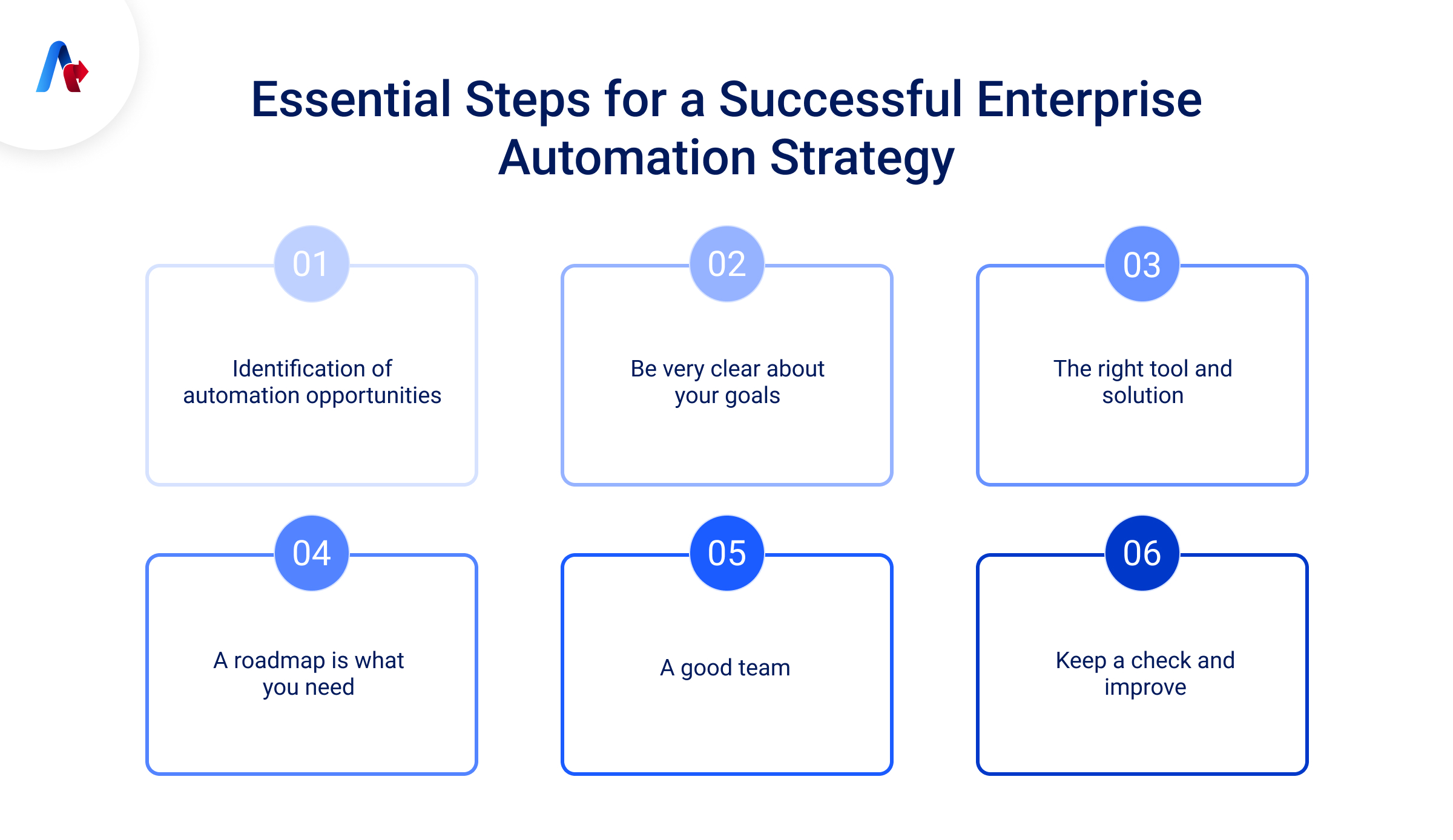Enterprise Automation
BLOG
10 min read
How Enterprise Automation Drives Growth: Key Steps, Benefits, and Success Stories
Competition in every business sphere reignites the question of efficiency at every phase of operations. It's the 24th century, and technology is growing every day. A report by Mckinsey highlights that automation has become fundamental for businesses as 66% of companies have automated at least one business function, while 31% are planning to implement automation in the upcoming future. With such a demand for effectiveness, enterprise automation has become a solution to drive productivity and reduce operational expenses.
But what is enterprise automation really? The basic concept of enterprise automation is implementing technology to automate repetitive business processes within an organization. From regular tasks like data entry to complex functions like managing workflows and customer interactions, every operation is being automated to minimize the need for human intervention and reduce errors.
With technologies like robotic process automation, artificial intelligence and machine learning in the market, automation has gained a more structured shape. These technologies have made a difference while making processes smooth and more authentic decision-making, resulting in business efficiency. As reported by Deloitte, a business using enterprise automation solutions witnesses more than 30% cost deduction by automating repetitive tasks.
While discussing enterprise automation, we picture large organizations adopting machinery and technologies to automate their tasks. But this is wrong; enterprise automation is not only for more prominent organizations. SMEs have gained good results by automating their code processes, ensuring that their employees can perform high-value tasks. You can automate customer support, logistics or financial workflows; everything is possible in enterprise automation.
This article will discuss the different types of enterprise automation, their benefits and how your organization can structure an effective enterprise automation strategy to meet your business objectives and goals.
What Is Enterprise Automation?
Before jumping into the complex attributes of enterprise automation, let's articulate a clear idea of enterprise automation. Enterprise automation is not just concerned with using technology to complete tasks rapidly. It is more about resetting how your business functions. Using technologies, including robotic process automation, artificial intelligence and machine learning, helps your companies eliminate repetitive tasks while allowing teams to emphasize creative and strategic initiatives.
It's more like adding a brain to your organization. Enterprise automation solutions help information flow seamlessly, decisions are made accurately and quickly, and operations are optimized. There are financial gains and an increase in speed, but most importantly, you have an agile organization capable of handling challenges in real time.
Enterprise automation might involve streamlining customer support, coordinating logistics or managing economic documentation. Enterprise process automation helps grow your business, making it innovative and competitive. The real power of enterprise automation is its ability to create more space for human potential. Welcome; please focus on what truly matters: innovation and growth.
What Are the Types of Enterprise Automation?

Enterprise automation has many types, each designed to help businesses automate different processes. The main types of enterprise automation that companies can use include:
Business Process Automation
Business Process Automation focuses on automating routine and repetitive tasks in different departments. For example, BPA automates activities like data entry, customer service and invoice processing. Businesses can save time and reduce human error by using this particular type of automation.
Robotic Process Automation
Robotic Process Automation utilizes software robots to imitate human actions and complete routine tasks. These bots perform actions like logging into applications, extracting data from them and even managing process transactions. RPA has the capability of automating back-end activities like payroll, data management and claim processing for the benefit of businesses.
Intelligent Process Automation
Intelligent Process Automation is a high-end automation strategy as it combines RPA with advanced technology like AI and machine learning to automate complex activities that require decision-making and problem-solving. IPA helps businesses automate activities like analyzing large data sets or managing customer queries with AI-powered chatbots.
Workflow Automation
Enterprise workflow automation covers the automatic flow of activities and approvals within a business. For example, if an employee applies for leave or requires purchase order approval, these systems ensure that the proper steps are taken correctly without delay. It maximizes efficiency and streamlines the process.
Enterprise IT Automation
As the name suggests, IT automation consists of automating activities related to IT systems, such as software updates, cyber security and system monitoring. It facilitates critical IT infrastructure and ensures that everything runs efficiently without any human intervention. It minimizes downtime and improves system security.
So, these are the kinds of automation businesses can implement to improve operations and drive growth.
Ready to transform your enterprise with automation?
Contact us to get startedBenefits of Using Enterprise Automation

The adoption of enterprise automation is like giving your business a turbo boost. It is not just confined to streamlining activities; instead, automation changes the approach through which a company operates. It provides value in different ways, and here are some of the benefits for modern enterprises:
Efficiency as Never Before
All critical tasks are done at lightning speed, without any error. Enterprise automation eliminates time-consuming and routine tasks by automating workflows, starting from data entry to approval management. This creates a clear pathway for employees to focus on high-end tasks required in human creativity and strategic thinking. Work smart, work timely!
Reduction in Expenses
Automation is not just about saving time; it also saves money. Businesses that are currently implementing enterprise process automation have seen a critical reduction in their operational expenses. Replacing manual labor with automation would reduce errors and safeguard your financial side. The amount of money saved can be used to reinvest in growth.
More Accuracy and Fewer Errors
Humans are prone to errors that can be costly for a business. It can be any error starting from a minute financial mistake or an overlooked customer query, mistakes lead to faulty systems. Regarding enterprise automation, specifically RPA, the tasks will be carried out consistently and correctly without the vulnerability of any errors occurring.
Be More Flexible
Business growth is directly linked to the intensity of demand. Automation provides firms with the flexibility to scale operations without hiding extra teams. Enterprise workflow automation helps the organization handle workloads while adapting to changes and streamlining complex process management.
How to Develop an Effective Enterprise Automation Strategy?

A thoughtful execution and a well-structured enterprise automation strategy are optimum requirements for businesses looking to automate their tasks. Let's dive into the specifics of maintaining an effective automation process.
Identification of Automation Opportunities
To begin with, you have to understand your business processes. Identify tasks that are time-consuming and routine or might be prone to human error. These are the main areas where you should invest in automation. Look across every department, from finance to HR, and focus on particular areas where enterprise process automation will have the most impact.
Be Very Clear About Your Goals
Do not rush into the automation process! You need to understand your goals—what do you want to achieve with automation? It can be anything: detecting expenses, increasing efficiency or increasing customer service. Prepare a good vision that will guide your strategy. Every goal should be measurable and achievable. Learn SMART goals!
The Right Tool and Solution
Always seek expert advice while selecting the right enterprise automation solutions. Different tools are available in the market, such as robotic process automation, AI-powered systems and workflow automation software. Each one has its tense, so focus on selecting the one that is resonant with your business needs. The system you select should integrate with your existing systems to perform smoothly.
A Road Map Is What You Need
The implementation plan should be detailed, with highlighted activities and a timeline. For smooth adoption, the automation process should be gradual and not forced. Emphasize processes depending on their impact and ease of automation.
A Good Team
Automation might be new to your employees, so don't stress out. You should invest in your team's understanding of automation. This will determine the effectiveness of your adoption process. Always provide necessary workshops to train your employees regarding the operations of automation enterprise systems and their benefits.
Keep a Check and Improve
Once you have executed your plan, you must understand the areas of impact. You should study your strategy and review how the system is benefiting your business. Always be ready for transitions, as there might be situations where you have to expand your strategy to keep it effective.
Enterprise Automation Examples and Use Cases
Enterprise automation has benefited many organisations and transformed their operations. Let's examine Accelirate, a leading automation company, and witness how it has changed the functioning of its clients.
Automation of Data Entry for a Healthcare Company
Having several EMR systems made it difficult to coordinate care and delayed access to patient data, which presented serious problems for the digital Diabetes Care Management organization. To solve these problems, they looked for a way to combine data from several EMR systems into a single platform that would allow the care management team to access data in real time. Salesforce Health Cloud, which was selected for its capacity to improve care delivery and expedite patient data management, was implemented in collaboration with the company by Accelirate.
12 mins read
Streamlining Patient Data with Salesforce Health Cloud Integration
Read More on Case StudyInventory Management Optimization Automation for a Manufacturing Company
A major distributor of electronic components partnered with Accelirate Inc., to solve issues with ineffective return tracking and manual reordering procedures. Due to the client's difficulties with predictive skills and limited visibility into inventory use, sales opportunities were lost, and expenses were up. To increase the efficiency of processing sales orders, they sought to expedite order fulfillment with shorter lead times.
Accelirate used Salesforce, SAP SD Module, SAP Analytics Cloud, and MuleSoft connection to create a complete real-time inventory management system. This strategic strategy sought to give the client the tools and insights they needed to efficiently meet consumer requests and manage inventory operations.
12 mins read
Optimizing Inventory Management with Salesforce and MuleSoft Integration
Read More on Case StudyWeb Security Automation for a Financial Organization
Accelirate worked closely with HSBC Bank to update their digital capabilities, especially tackling the issue of giving staff members quick and safe access to Citrix apps. The inefficiencies and security threats of maintaining numerous login passwords for different online applications housed on Citrix servers were a challenge for HSBC.
HSBC developed a complete Single Sign-On (SSO) solution in collaboration with Accelirate, a reputable MuleSoft partner. Accelirate guaranteed a smooth communication structure between HSBC's systems, including an Oracle database and Citrix servers, by utilizing MuleSoft's sophisticated integration capabilities.
12 mins read
Accelirate's MuleSoft SSO Transforms Web Access Security for HSBC Bank, Saves 70% IT Admin Time
Read More on Case StudyFuture-Proof Processes Today with a Well-Planned Enterprise Automation Strategy
The amount of potential enterprise automation has made it more essential for sustaining and competing. Automating routine and repetitive tasks not only increases efficiency but also secures the company's financial outlook. Employees get the opportunity to emphasize strategic work more.
Accelirate is an AI and automation company that has showcased how enterprise automation solutions help organizations in a natural context. One thing that you need to consider is the development of a well-planned enterprise automation strategy that aligns with your goals and seamlessly integrates with existing systems.
So, it's high time to embrace enterprise process automation and say goodbye to errors!


